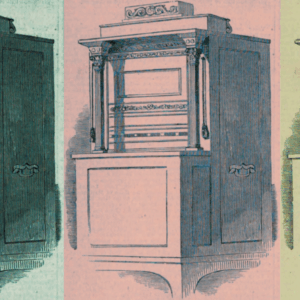
Why We Should Celebrate the 400th Anniversary of Shakespeare’s First Folio
Six Scholars on the Most Important 844,421 Words in Literature
Naturally much of the interest which an object like the folio generates is due to its rarity and expense as an object with only around 235 extant copies known to remain. What has your experience been working with or examining a first folio? What sorts of feelings or thoughts occur when being in the presence of that sort of text within the archive?
Emma Smith: One thing I’ve become more conscious of is the sound of the pages—crisp linen crinkles, washed (to remove stains or annotations) has a much softer page feel. And I’m always interested in how institutions present their copies. Dallas Public Library has a kind of Folio side chapel; at Dulwich College school, pupils mingle doing their homework as researchers look at this book.
Brandi Adams: The first thing that I would like to state on the record is that this particular First Folio of Shakespeare’s plays–of which there are 228 confirmed copies according to The Shakespeare Census– is not rare, though copies of it are very beloved, and astronomically expensive. There are other books of Shakespeare’s including the first quarto (small printed playbook) of Titus Andronicus (1594) that exists in a single copy. Now, that is rare. We are super fortunate to have so many copies in the world–especially now that they are being digitized for more people to read and examine.
As for my experience working with or examining a 1623 Shakespeare Folio: I think because I am interested in the labor and time that went into the construction of the book, and the efforts it took for groups of people to ensure that it came to press, I spend more time marveling at the construction, presentation, and weight of the copy. I have certainly spent less time with copies of this book than Professors Smith and Karim-Cooper. I think that if I were to see the copy of the 1594 Titus Andronicus at the Folger Shakespeare Library, I might indeed get a bit emotional because of its rarity and the fact that Shakespeare was very much alive during its production and publication.
Tiffany Sterns: As Brandi notes, the Folio is expensive but not rare. By comparison, just a fragment, one quire, survives of the first quarto of 1 Henry IV; while the first print run of Love’s Labour’s Lost (1597) is entirely lost. And what of Love’s Labour’s Won (1597?): a whole Shakespeare play was printed that has now disappeared (though do check your attics, folks). So one thing that makes working with Folios exciting is the fact that there are so many of them. As a result, they can be cross-referenced and compared, teaching us a lot about how and when the book was proofed, how many pages were corrected and so forth. When I’m in the presence of a Folio, I like, first, to look at what’s unique about that particular volume: which errors does it have on which pages (is it one of the versions with ‘his neither lip’ or ‘his nether lip’?), but also what does it reveal about its own progress over the centuries – who has written on it or marked it, and can I spot any leftover food in it (Folios were regularly kept on dining tables as they were too big for bookshelves. They often ended up full of food). I like to think, too, about the people and nature enwrapped inside the Folio. Paper was made of rags, not wood pulp at the time: what clothes might make up the Folio’s pages? Ink was made of oak galls: where did the trees grow that came to inscribe Shakespeare’s words? The men who rolled the ink onto the type would pee on their leather ‘ink balls’ in the evening to keep them supple. Whose long dead pee infuses the pages? I feel charmed and delighted and touched and fascinated by each Folio and the many people and things that, in all sorts of different ways, are within them.
Farah Karim-Cooper: In my research, I have worked a lot with facsimiles of the Folio and with actual Quartos. But I have seen three folios only, one of them we have here at Shakespeare’s Globe in London (the Munro copy kindly loaned by collector Marcus Coles)– where it is kept in a glass case. I remember when it first arrived. A colleague of mine and I saw it at Stage Door as it was unwrapped and displayed to us by our Collections Curator. I opened it and sniffed it. In fact, we both did. There is something about smelling books that has charmed me since my childhood. Shakespeare’s book smelled musty and miraculous to me.
Michel Whitmore: Because of the nature of the Folger’s holdings, I have been lucky enough to see and inspect dozens of First Folios. More significantly, I see them as a group. I will never forget seeing all 82 of the Folger First Folios displayed together along a storage wall in the vault – a wall that is now being recreated in a secure visible display that will present the First Folios as a collection to the public. As others have said so eloquently, the ability to compare First Folios allows us to appreciate the unique state and history of every copy. I am mindful, however, of the tension between displaying the Folios and working with them as an object of study. The folios will continue to be consulted by researchers, of course.
. I’ve seen adults cry in the presence of the book and I know of at least one marriage proposal that has taken place in front of a folio.
But there are basic questions about why someone would collect multiple folios and what kinds of prestige or exclusivity are conferred on the person or institution that possesses multiple copies of the book. The most interesting encounters I have had with First Folios are almost always around others. I’ve seen adults cry in the presence of the book and I know of at least one marriage proposal that has taken place in front of a folio. There’s something about the sheer fact of “Here, this is a real First Folio” that speaks to deeper questions about how real the world and person were that produced Shakespeare’s plays.
Are there any special features about the folio, any unique aspects which readers might find missing in contemporary editorial versions of those thirty-six plays, which you think are important to an appreciation of Shakespeare’s historical context?
Tiffany Stern: Oh, there are so many. Let’s start with the play I’m currently editing, The Tempest. The Folio’s Tempest contains a list of the characters in the play: men first; women second. That’s not how we would list characters or actors these days, but it reminds us of the gender dynamics in that play – as well as, intriguingly, putting Ariel, the male spirit, amongst the women. The Tempest is also given a ‘location note’ before the start: ‘an un-inhabited island’. What does it mean to call an island in which Ariel and Caliban have always lived, uninhabited? Other features we edit away are, like the two examples just discussed, probably for readers, not actors. The Merry Wives, The Two Gentlemen of Verona, and The Winter’s Tale, for instance, have ‘massed entrances’ in the Folio – that is to say that they have an initial stage direction at the top of a scene that lists all the actors who will be in that scene, even if they do not enter until later. Ralph Crane the scribe was a fan of ‘massed entrances’, which neatened plays up and made them look classical, and he probably wrote these ‘stage directions’ (they are in fact, ‘reader directions’). When we edit plays, though, we tend to have actors in mind, and place the entrances where they occur. Folio typos are also telling about the construction of the book. There are a lot of mistakes, for instance, around classical names and references showing that the poor compositors (typesetters) weren’t as good at guessing classical, as English, terms when trying to work out what messy plays were saying. One of my favorites is the moment when Coriolanus is praised for having been ‘a Souldier / Even to Calves wish’. This is nothing to do with baby cows: it’s a typo for Cato. We also preserve oddities from the Folio without realizing how strange they are: like the names Claudius in Hamlet, and Vincentio in Measure for Measure, which are never spoken on stage. These are book names, not performance names. Who came up with them and why?
Farah Karim-Cooper: There was a copy of the Folio discovered in St. Omer, France. It was brought to the Globe and I had the good fortune to thumb through it. The annotations were fascinating and showed it had been altered for performances by a group of Jesuit students in the 17th century—this tells us that the Folio was an active text and not necessarily locked behind glass or away in a vault, but that it was used by a group of performers who thought nothing of marking up their ‘script’.
Brandi Adams: I think that special features of unique copies include marginalia (notes from readers of the text) are something that would be marvelous to share with contemporary readers of edited Shakespeare plays. It might give them a better idea of how various readers encountered copies of the book including as text to be corrected; material to be commented on in terms of its ‘goodness,’ or plays to be acted with friends–or even as a place for other random observations that readers make. It would allow twenty-first century readers to understand that the book could have been a gift, something purchased second hand, or an unremarkable book in a personal library in which people felt comfortable writing arithmetic inside or using pages to practice writing their name.
Emma Smith: There are fantastic stage directions (or their absence) throughout the First Folio: I think the depiction of Aaron in Titus Andronicus is a really fascinating example. He’s introduced in a Folio stage direction ‘Enter the Emperor, Tamora and her two sons, with the Moore’, but in his next scene, he is ‘Enter Aaron alone’. Modern editions smooth out these kinds of things as distracting inconsistencies, but they give lots of possibilities. Anyone who’s studying a play: have a look at the stage directions in the folio text, and see how your modern editor has added, reshaped, or standardized them.
Michael Whitmore: So many great things have already been said. I would add that a printed page of the First Folio can be both mystifying and illuminating for modern readers. The two columns of text will feel foreign to many, as will the early modern spelling. These are the most obvious differences, and they are specific to the period and format of the text. But these differences alone can be striking for a modern reader.
The folio, as pricey as an individual copy may be, still represents a work from the time period for which we have a lot of extant copies. What are some other titles printed in the seventeenth-century that you think deserve more attention than they receive in the popular media?
Brandi Adams: In 1623, Samuel Daniel (a wonderful poet, who was rather popular at the time–particularly at Cambridge University) also had a posthumous collection of works entitled The Whole Works of Samuel Daniel Esquire in Poetry. His brother helped to usher this book into publication. I firmly believe that this work deserves far more attention, but unfortunately it has been overshadowed by Shakespeare.
Tiffany Stern: The next massive folio of plays to be published after Shakespeare’s was Francis Beaumont and John Fletcher’s Comedies and Tragedies (1647). As one of those men, Fletcher, co-wrote at least The Two Noble Kinsmen with Shakespeare, as well, perhaps, as Henry VIII and the lost Cardenio, he was to some extent learning his craft from Shakespeare. He went on to write a play, which can be found in his Folio, called The Tamer Tamed, which is an answer to Shakespeare’s The Taming of the Shrew. In Tamer Tamed, Kate (‘the shrew’) is dead, and Maria, the new wife, takes it upon herself to tame Petruchio back – reversing Shakespeare’s comedy. There’s a lot to love lyrically in Beaumont and Fletcher’s Folio too. Here’s a verse that is sung to the dying Valentinian – he has been poisoned – to help him sleep:
Care-charming Sleep, thou easer of all woes,
Brother to Death, sweetly thyself dispose
On this afflicted prince; fall like a cloud
In gentle showers; give nothing that is loud
Or painful to his slumbers; easy, sweet,
And as a purling stream, thou son of Night,
Pass by his troubled senses; sing his pain,
Like hollow murmuring wind or silver rain;
Into this prince gently, oh gently slide,
And kiss him into slumbers like a bride.
There are 35 Beaumont and Fletcher plays in their Folio, just shy of the number in Shakespeare’s, and the book shows amazing collaborative writing, while giving a sense of the kinds of writing Shakespeare inspired.
Michael Whitmore: I too have a hard time moving on to other books, since there’s still so much to content with in Shakespeare’s First Folio. Not a particularly rare book, but I think Calvin’s Institutes of the Christian Religion is a defining work of the sixteenth century, one whose influence reaches deep into Shakespeare but also well beyond. When I think of the First Folio, I think of the power of the printing press to carry ideas and sensibilities well beyond the ambit of an individual person. Without putting a damper on the Shakespeare party, I would say the Protestant Reformation still feels like cultural event that continues to steer arguments and ways of seeing the world in the West. Shakespeare wrote great stories, but the Reformation kind of set the terms against which stories would be measured.
Farah Karim-Cooper: I often joke that if there was a Montaigne’s Globe, that’s where I’d want to work. Michel de Montaigne is my favorite sixteenth- century writer. He was a French essayist and philosopher who died in 1592, when Shakespeare was just getting going. His essays were translated into English by John Florio in 1603 and this has always felt significant to me. It is widely accepted that Shakespeare was inspired by Montaigne who probably accessed his work in manuscript form. You can see the shaping influence of some of his essays – ‘Des Cannibales’ is often cited as inspiring sections of The Tempest and I am a strong believer that his essay ‘To Study Philosophy is to learn to die’ inspired not just Hamlet but Shakespeare’s other ruminations on death—such as Julius Caesar’s ‘Cowards die many times before their deaths’. The essay reminds us that it is foolish to fear death because it is coming. If we don’t come to terms with that fact, we won’t know what it means to truly live. We need more Montaigne in our lives.
Emma Smith: This question made me realize that in 2023 I’ve drunk the First Folio Kool-Aid. Another book! What can you mean? Joking apart, I’m looking forward to getting back to some of the other playwrights — Middleton, Jonson, and especially Fletcher.
Of the plays throughout the folio, histories, comedies, tragedies, plays like Hamlet, King Lear, MacBeth, and Othello, characters from Prospero to Shylock, Ophelia to Cleopatra, is there a particular work—or character—or passage—that you think speaks to our current moment? Do you have—as embarrassing a question as this might be—a favorite?
Brandi Adams: If pressed, I would say that Richard II is a play that very much speaks to the current moment even as it is about medieval English history. The play sharply examines fundamental questions we all have about nations: who has the right to lead; who is considered a legitimate citizen; and who we are willing to stand by in a time of political crisis and social upheaval.
My favorite character in all of Shakespeare is also from that play—The Duke of York. This is mostly, because he flails around and cannot make decisions easily because of various conflicting feelings. He suffers from information overload, which includes both a broad understanding of the political landscape in which he is forced to live, and weight of familial and national history in ways that other characters do not. His attempt to remain “as neuter” is impossible, yet the more times I read the play, I understand better why he attempts to keep his family and the nation together, even as it is tearing at the seams.
Tiffany Stern: As habits of thought change, so different bits of Shakespeare become important at different moments. A lot of people are thinking deeply, these days, about the passage in Midsummer Night’s Dream which is about climate change: ‘The seasons alter’ and ‘hoary-headed frosts / Fall in the fresh lap of the crimson rose’. For myself, I’m reminded, whenever I read the news, of a bit of Henry V. Exeter, speaking on behalf of the king, says ‘take mercie / On the poore Soules, for whom this hungry Warre / Opens his vastie Jawes’. He goes on to depict the horrors of war:
the Widdowes Teares, the Orphans Cryes,
The dead-mens Blood, the privy Maidens Groanes,
For Husbands, Fathers, and betrothed Lovers,
That shall be swallowed in this Controversie.
It’s a bleak acknowledgement of way war consumes. And yet this is a manipulative speech to persuade another country, France, to choose to surrender territory to England … It’s complicated and vicious and we’re seeing versions of all of it right now.
Michael Whitmore: The play that is most of the moment feels like 2 Henry VI, with its depiction of the populist figure of Jack Cade. His line, “My mouth shall be the Parliament of England,” is such an amazing, all-encompassing declaration. It’s as if a single person is gobbling up the social contract. It is always risky to infer political sensibilities from plays, but the Cade episode feels to me like a heartfelt commentary on where populist politics can lead. There are of course other forms of government that show their flaws in Shakespeare’s plays, and I doubt Shakespeare had any conception of what we think of as participatory democracy. But Shakespeare’s plays say a lot about participation in power – and non-participation. Jack Cade feels like a resonant example today.
Emma Smith: One feature of Shakespeare’s constant creative reinterpretations is that surprising plays suddenly pop up as resonant with a particular moment. There are famous recent examples: Troilus and Cressida during Vietnam, Julius Caesar in the Trump presidency, Measure for Measure as a #MeToo play. What these echoes tend to bring out is the complexity of the issues as Shakespeare depicts them, and the shades of grey in these issues. It’s hard to look to Shakespeare for an answer on these recurrent problems, but he’s pretty unflinching in setting them out.
Farah Karim-Cooper: My favorite play and the one that comes to mind as speaking to our current moment is Shakespeare’s first tragedy, Titus Andronicus. He likely collaborated with George Peele to produce this play, but it’s certain Shakespeare wrote most of it. It is set in ancient Rome, so it is interested in the relationship between empire and identity. While we don’t necessarily think about the British empire or even conceive of America as an empire, we are still living within structures where minoritized people experience the tools and remnants of imperial oppression. The character of Aaron the Moor is Shakespeare’s first exploration of Black identity – and while it is full of stereotype and anti-black characterizations, it is hard to deny the nuance and complexity of his representation. He isn’t simply a villain or a reiteration of the vice figure, he is also empowered by his difference and gestures to his blackness as something to love and that is worth fighting for.












